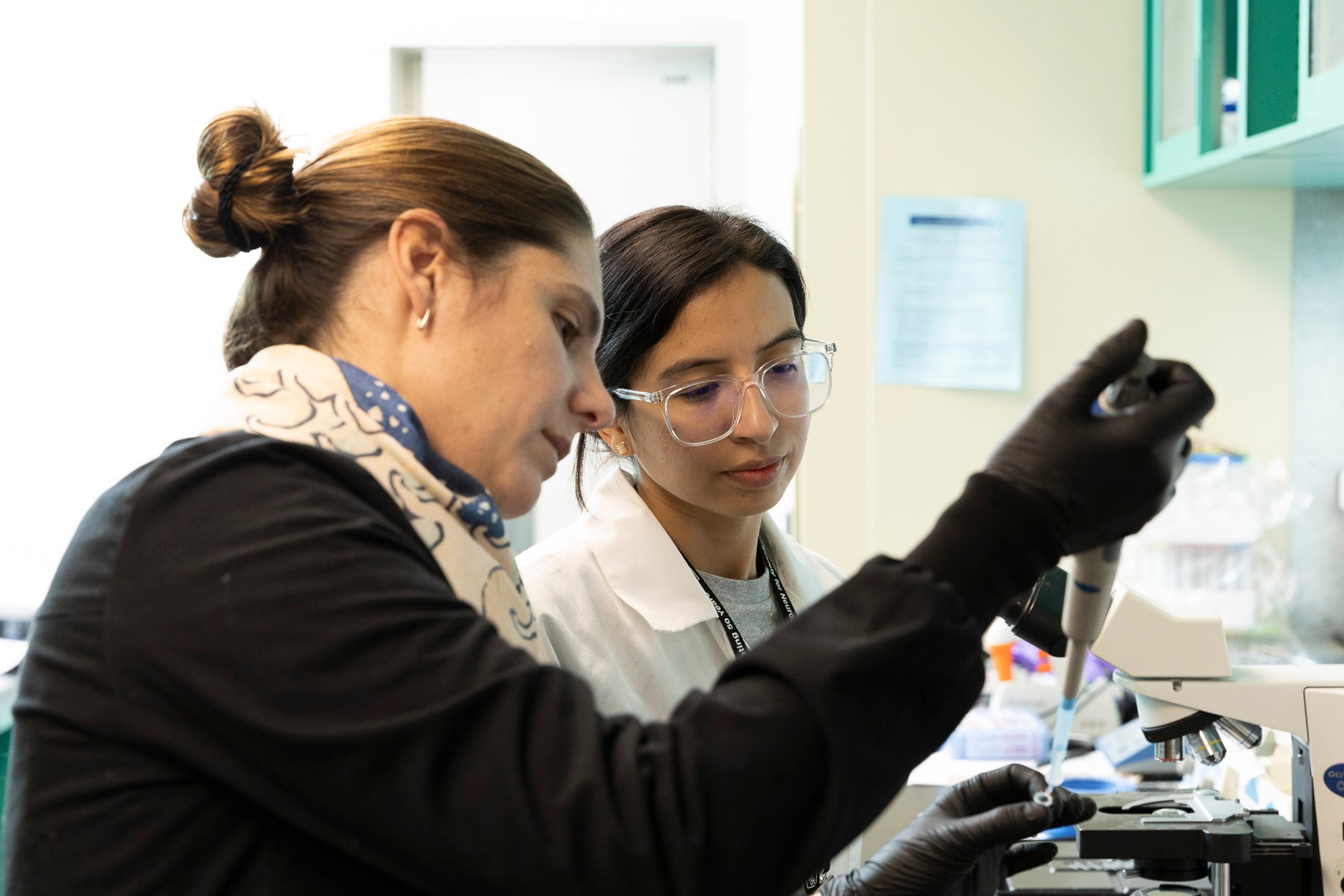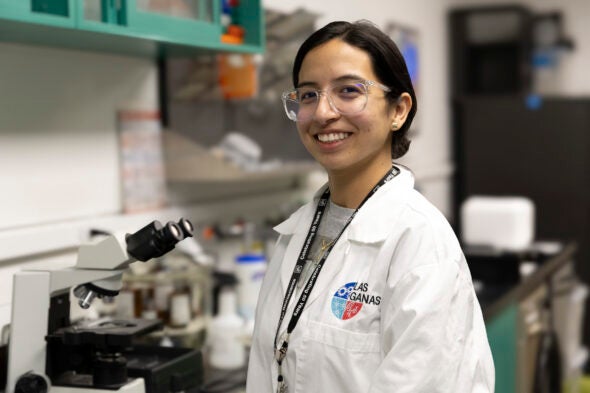How UIC encourages Latino graduate students

When Rosa Elena Mendoza was growing up on Chicago’s South Side, she couldn’t wait to finish high school. She wanted to start college so she could help support her family, who strived to come to the United States from Mexico for a better life.
She participated in a dual-enrollment program at a Chicago community college, where she earned an associate’s degree. There she learned of another program that directed students to the University of Illinois Chicago.
At UIC, she found a home. After earning her bachelor’s degree in biological sciences over three years, the 22-year-old went straight to graduate school. Mendoza, the first in her family to attend college, is now in her second year of a five-year program to earn a doctorate in biological sciences with a concentration in neuroscience.
What attracted Mendoza to UIC was its designation as a Research 1 institution and that it is the only public research university in Chicago. Also attractive was its role as a Hispanic-Serving Institution that emphasizes recruitment of graduate students and faculty of color through innovative programs that have made UIC one of the most diverse public universities in the country.
“To be a Latina pursuing a PhD at an R1, Hispanic-Serving Institution like UIC is a profound mix of pride, gratitude and determination,” said Mendoza. “It’s a journey that carries the weight of generations before me — those who sacrificed, dreamed and worked tirelessly to ensure I could sit in classrooms they never imagined stepping into.”
UIC ranks among the top 50 universities in graduate enrollment and total graduate degrees conferred to Latino students. It’s now among the top 10 for doctorate degrees granted to Latinos, according to Hispanic Outlook in Higher Education Magazine.
David Eddington, dean of UIC’s Graduate College, said one focus of the graduate college is on retaining students like Mendoza, as they enter graduate school. Because the UIC undergraduate campus ranks among the most diverse in the country, they want to encourage undergraduates of color to stay at UIC and earn their graduate and doctoral degrees.
“The idea is that departments start looking inward at our students as potential graduate students and then that’s going to hopefully increase the diversity of the graduate programs even more,” said Eddington.
This is done through programs like the Summer Research Opportunity Program, which offers research experiences to any undergraduate student but concentrates on students from underrepresented backgrounds. The eight-week program gives students faculty-supervised research experience at the undergraduate level and is a pipeline to graduate school. Mendoza went through the program and received a fellowship to pursue her doctorate at UIC.
Eddington also pointed to UIC’s Bridge to Faculty initiative, a recruitment program to attract underrepresented postdoctoral scholars and help them transition to tenure-track junior faculty positions after two years. This initiative aims to bring and retain promising scholars at UIC and to diversify faculty.
“The biggest thing you can do to increase graduate student diversity is have a diverse faculty that looks like them and comes from the same backgrounds,” said Eddington.
Campus programs support Latinos
Lunaire Ford, associate dean for outreach and educational innovation in the Graduate College, said UIC’s Latino population has grown significantly as more Latino students in the area and the country have become college age. This growth has made UIC a Hispanic-Serving Institution on the undergraduate level, which requires that 25% of a university’s enrolled students are Latino/Hispanic.
At the graduate level, representatives of the UIC Graduate College attend national conferences, where Latino graduate students may be presenting research projects, to recruit them to UIC and tell them about the university’s research. Most doctoral students at UIC come from California, Texas and Illinois.

UIC also has become more intentional about directing local undergraduates to its graduate and doctoral programs, said Ford. This includes targeting students “further down the pipeline” and networking with two-year community colleges. The aim is to reach students like Mendoza.
“We are doing much more outreach to let students in the Chicago and Chicagoland area know about opportunities for graduate studies at UIC and the benefits of attending UIC and achieving graduate degrees and PhDs,” said Ford.
Ford said support programs at UIC can help Latino students feel at home. One such program is the Latin American Recruitment and Educational Services, or LARES, begun in 1975. LARES recruits Latino students to UIC and supports them academically, which increases their chances of success.
“They have a full one-stop shop of professionals who are working there in terms of advisement and financial support and everything else that students need to succeed in college, but also to make them aware about opportunities at the graduate level,” said Ford.
Programs that support Latino and undocumented students at UIC include the Latin@s Gaining Access to Networks for Advancement in Science, or L@S GANAS, created to ensure Latino students in STEM fields succeed, and the Rigo Padilla Pérez Undocumented Student Resource Center, founded in October 2023 as a sanctuary for undocumented students at UIC. The center provides resources and services for current and prospective students and their families with undocumented or mixed immigration status. Also, since 1976 the Rafael Cintrón Ortiz Latino Cultural Center has been a welcoming space for Latinos and anyone wanting to learn more about Latino communities and advocate for social and environmental justice.
UIC as a leader
Theresa Christenson-Caballero, director of graduate student professional and career development in the Graduate College, earned her master’s degree at UIC. She said one reason the university ranks among the top 50 schools conferring graduate degrees to Latinos and among the top 10 granting doctorates to Latinos is that the diversity of staff and faculty encourages Latinos to earn their doctorates at UIC.
“If you have Latino faculty in place, the rates of those PhD scholars are going to expand because of that interest in those particular scholars, their research, cultural competence and understanding their perspectives,” said Christenson-Caballero.
For the last eight years, she has directed Pipeline to an Inclusive Faculty program. The initiative has a 91% retention rate and recruits and supports Black, Indigenous and people of color doctoral students interested in becoming faculty. Christenson-Caballero also co-chairs the Chancellor’s Committee on the Status of Latinos at UIC, representing Latino staff, faculty and students in voicing their concerns on campus.
Mendoza said having faculty members who can relate to her upbringing and circumstances as a first-generation American makes her feel comfortable as she learns new material and continues toward her doctorate. She works in a research lab under Assistant Professor Angeles Salles, who is from Argentina and can communicate in Mendoza’s first language, Spanish.
“She always makes me feel comfortable. I really wanted to stay at UIC for my PhD because I found someone I could relate to,” said Mendoza. “I see a lot of that at UIC; there’s so much diversity and many opportunities.”
A version of this article appears in Hispanic Outlook in Higher Education Magazine.
